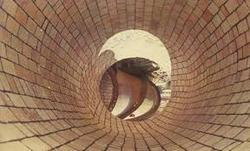
The material in solid form which has the capability of withstanding its shape at very high temp of about 1650°C.
• Safeguard boiler casing from overheating and distortion and possible resulting in leakages of gases.
• To decrease heat loss as well as allow cold face for operator
• To safeguard exposed parts of drum and headers
• act as heat reservoir.
• Used also as baffles for directing gas flow
PROPERTIES OF GOOD REFRACTORY
- Good insulating properties
- With stand high temp
- Good mechanical properties
- With stand vibrations
- With stand cutting and abrasion action of gases and dirt
- Able to expand and contract without cracking
TYPES OF REFRACTORY
- Acid materials: clay, silica, quartz, sandstone etc
- Neutral materials: chromite, graphite, plum bag, alumina, Alkaline or base material: lime, magnesia, zirconia
Composites
- Fire bricks
- Monolithic
- Mouldable
- Plastic chrome ore
- Castable refractory
- Insulating material
FAILURE OF REFRACTORY
- Spalling
- Sagging
- Shrinkage cracking
Precautions to be taken during and after installation of boiler refractory:
1) To prevent undue stresses in the refractory material ample space should be provided for expansion. It is made to ensure that the these spaces does not get blocked in any way and cause refractory to break off from attachment and bulge out, with danger of possible collapse.
2) Refractory material determines the time required for raising the steam. So greater amount of the refractory slows down the steam raising process to prevent damage to refractory.
3) Air dampers or checks should be closed as soon as boiler is shut down preventing cold air impingement on the hot refractory. This impingement causes surface flaking which is commonly known as Spalling. Spalling causes reduction in wall thickness of the refractory.
4) Flame impingement should be avoided on refractory as this causes build up of carbon deposit on the surface. The carbon penetrates into the refractory and damages the same.
5) Impurities in fuel like vanadium and sodium salts react with refractory material to form molten slag, which runs down to the furnace floor. This causes reduction of wall thickness and building up of this slag interferes with the shape of the flame. Thus impurities should be prevented from entering the boiler.
Different Causes for boiler refractory damage
• Improper installation of the refractory
• Installation of wrong shape ferrules
• Improper refractory dry out post installation leading to thermal shock
• Improper shut down operation leading to rapid cooling of the refractory
• Ceramic cracking as a result of the thermal, structural or mechanical stresses
• High temperatures inside the furnace by improperly using a higher level of oxygen or loss of temperature control system
• Failure due to corrosion resulting in cold spot, acid formation and undesired chemical reactions
• Improper velocity of the flame
• Erosion due to the improper high loading under tension
• Vibration as a result of improper design
• Improper refractory selection



